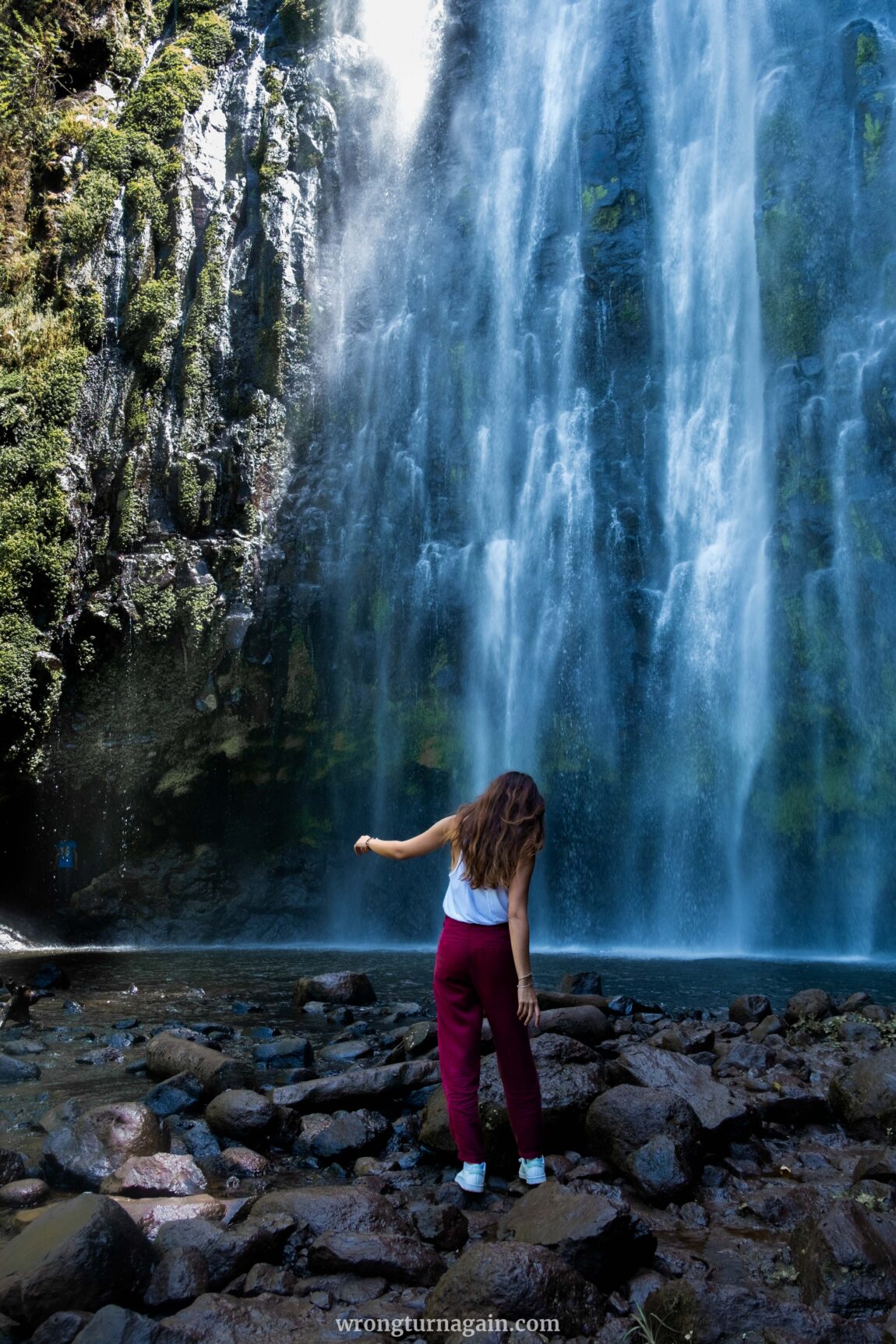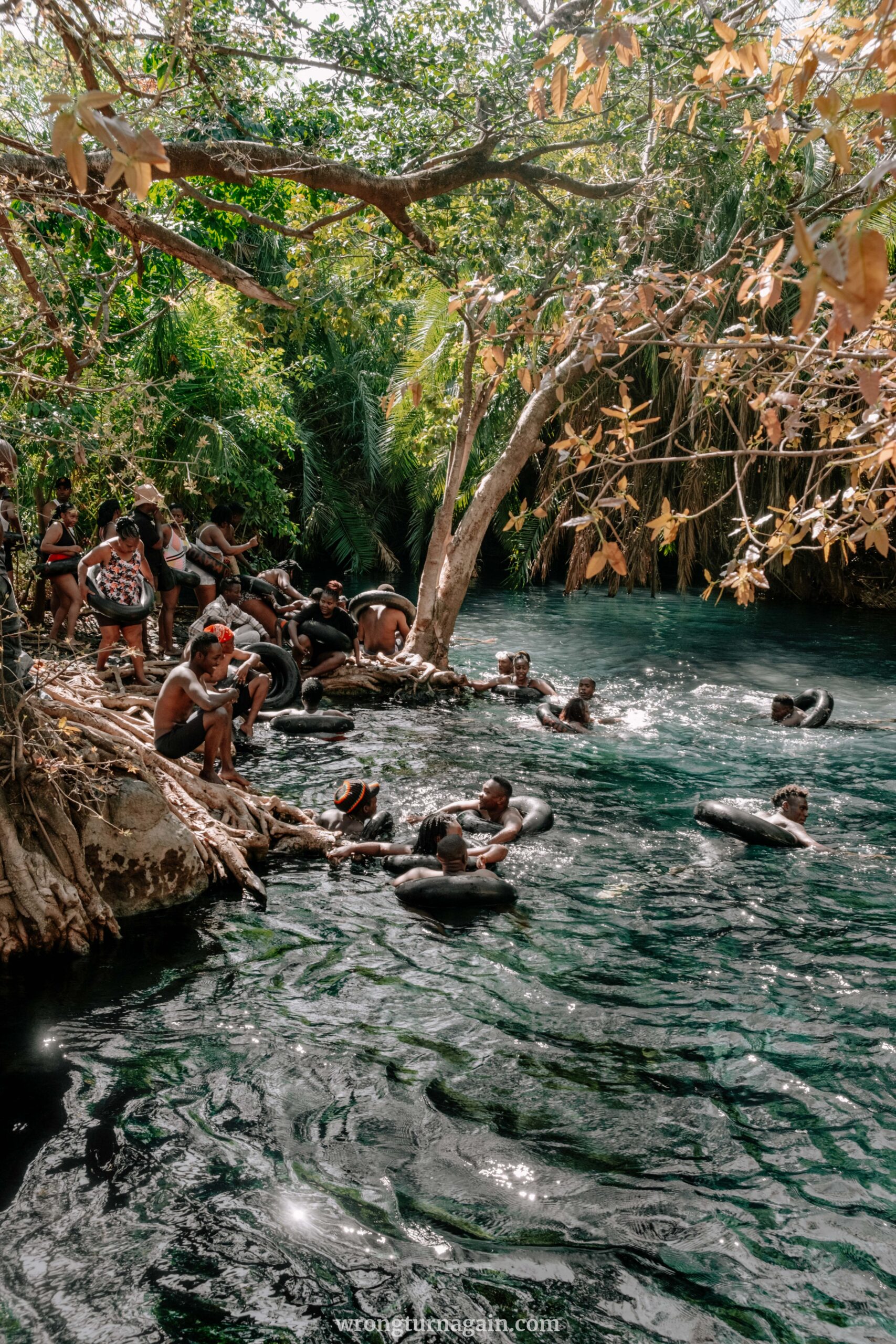
Nestled in the lush foothills of Mount Kilimanjaro, the village of Materuni remains one of Tanzania’s best-kept secrets. Famous for its breathtaking waterfall and aromatic Arabica coffee, it welcomes you with scenic forest trails and the warm hospitality of the Chagga people, who invite you to discover their traditional coffee-making process and local cuisine.
Here’s our complete guide to the best things to do in Materuni — plus practical tips on how to get there, where to stay, what to eat, and when to visit.
Top Things to Do in Materuni Waterfall Village
Materuni is a small mountain village in northern Tanzania, sitting at an elevation of around 1,600 meters. It’s an ideal stop for travelers exploring the north — whether it’s after a safari in iconic parks like Serengeti and Ngorongoro or before/after summiting Mount Kilimanjaro.
Framed by a breathtaking waterfall and surrounded by lush banana and coffee plantations, Materuni invites you to partake in experiences that connect you intimately with both nature and the indigenous Chagga culture.

1. Hike to Materuni Waterfall
The main attraction for visitors is, unsurprisingly, the impressive Materuni Waterfall. Locally known as Nambe (“the firstborn”), it is the first significant waterfall formed by waters descending from Kilimanjaro.
The waterfall complex includes smaller cascades, with the largest drop reaching about 70–80 meters. Powerful waters plunge into a natural pool at the base, surrounded by tropical vegetation—an idyllic spot for a refreshing dip.
Materuni Waterfall Hike: How to Reach the Falls
The trail begins at the drop-off point for boda-bodas (motorbike taxis) and cars, where you also pay the entrance fee (location here). The path follows a dirt road through banana plantations, coffee farms, and traditional Chagga homes. On clear days, you get spectacular views of Mount Kilimanjaro looming in the distance.
The walk is gentle, with only a slight change in elevation, and remains accessible even in the rainy season, when the path turns muddy. As you move deeper into the greenery, the distant sound of water gradually grows louder, guiding you forward—until, at last, the cascade breaks into view, a striking veil of white framed by the lush forest.
Should I Hire a Guide for Materuni Waterfall Hike?
The trail is not marked with signs but is popular enough to encounter other hikers. You can also use this map to navigate.
While a guide isn’t necessary to reach the falls, having a local guide enhances your experience with cultural insights and greater understanding of the local flora, while also supporting the Chagga community directly.

Fun Fact: An interesting plant you’ll encounter is the Dracaena afromontana, or “forgiveness plant”. In Chagga tradition, folding one of its leaves and leaving it at someone’s doorstep is a way to ask for forgiveness. The recipient can accept the apology by unfolding the leaf or reject it by leaving it closed—a profound example of the Chagga’s deep connection to nature.

2. Try Traditional Banana Beer (Mbege)
On the way to the waterfall, you’ll come across small wooden huts roofed with banana leaves. Outside, groups of locals gather around makeshift tables, sharing large plastic cups filled with traditional banana beer, known as mbege.
Mbege accompanies every social occasion—from celebrations to casual get-togethers. Even if the taste doesn’t win you over, it’s worth trying for the cultural experience – and trust us, someone nearby will gladly finish your share.
How Mbege Is Made – Traditional Chagga Banana Beer
Making mbege, the traditional banana beer of the Chagga people in Tanzania, is a slow, labour‑intensive process that relies entirely on natural fermentation of bananas and finger millet. This age‑old craft is traditionally the work of Chagga women and has been passed down through generations.
It begins with fully ripe bananas of the local ndizi ngombe variety (“cow bananas”), which are boiled for hours until the mixture thickens and turns a deep reddish‑brown. The banana brew is then left to ferment naturally for 2 to 5 days, until tiny white bubbles appear on the surface — a clear sign that fermentation is underway.
Meanwhile, finger millet is ground and cooked with a little water to create a porridge known as mso. This millet porridge is mixed into the fermented banana base along with quinine bark, adding subtle bitterness and depth of flavour. The combined mixture ferments for another one to two days before being strained and ready to drink.

Did you know? On the first day, mbege has very low alcohol content (around 0.5–1.5%). As the days pass, the strength increases. The flavour is truly unique — fruity and mildly sweet from the banana, balanced by the gentle bitterness of quinine, and finished with a soft, natural fizz from the fermentation process.
3. Discover the Art of Coffee: From Bean to Cup
In Materuni, coffee is much more than a simple product — it’s part of daily life and at the core of Chagga identity. Across the village, small family farms open their homes to travelers, sharing step by step their traditional coffee-making process: from the moment ripe cherries are picked from the tree, to brewing fresh, aromatic Kilimanjaro coffee in your cup. This is an experience you absolutely shouldn’t miss during your visit.

How is coffee grown in Materuni?
On the fertile slopes of Mount Kilimanjaro, Chagga farmers cultivate the renowned Kilimanjaro coffee — mostly Arabica, with a touch of Robusta — in rich volcanic soil, intercropped with banana trees.
This traditional agroforestry practice is a generational secret: bananas gently filter the sun, retain soil moisture, and their roots enrich the earth with valuable nutrients. The result? Beans with a clean, balanced flavor and an intoxicating aroma.
💡 Did you know? The coffee cherries are picked exclusively by hand, and only once they reach perfect ripeness. After harvesting comes a meticulous process: removing the pulp, natural fermentation, thorough washing, and sun-drying on large wooden racks. This drying stage can take 6–8 weeks, allowing each bean to reach the ideal moisture content for roasting.
Participate in the Traditional Coffee Ceremony in Materuni
In Materuni, coffee making is not just observed — it is fully experienced. Joining local guides, you actively take part in every step of the traditional Chagga coffee ceremony accompanied by songs and rhythm that reflect the community’s rich collective spirit. Coffee here is more than a drink; it’s a cultural celebration.
The process begins when you pound dried coffee beans with a heavy wooden pestle in a wooden mortar, revealing the white inner beans. Next, the husks are skillfully separated in baskets woven from banana leaves through shaking and rotating motions. The beans are then slowly roasted over an open fire until they turn a deep, aromatic dark brown.
Once cooled, the roasted beans return to the mortar where they are ground into a fine powder. This freshly ground coffee is boiled in a pot and served hot in a communal container, inviting everyone to share in this authentic, immersive coffee experience.
4. Taste Authentic Chagga Cuisine in Materuni
Your journey through the world of coffee in Materuni often ends with a warm, home‑cooked meal prepared by your Chagga host family. The traditional Chagga cuisine is rooted in simple, locally sourced ingredients such as cassava, sweet potatoes, beans, and leafy greens — with bananas taking center stage in many dishes.
Some of the standout dishes you might try include:
- Makuru (or Mangararu) – A wholesome mix of maize, beans, and ripe bananas, boiled together until they reach a creamy, uniform consistency.
- Machalari — A rich stew made with bananas, beef, and coconut milk, slow‑cooked until the ingredients meld together into a thick, flavorful sauce.
- Mtori – A hearty, velvety soup featuring tender pieces of beef (usually), potatoes, and green bananas, which are mashed during cooking to create a smooth texture.

Note: The dishes you’ll enjoy depend entirely on the host family you visit — there’s no set menu. Meals are often vegetarian, so if you wish to try meat‑based Chagga dishes, you may need to visit a local restaurant in nearby Moshi.


How to Get to Materuni
Materuni village is located in Northern Tanzania, nestled in the foothills of Mount Kilimanjaro at an elevation ranging roughly between 1,500 and 1,700 meters, depending on the part of the settlement. It lies 13 km from Moshi, which in turn is 80 km from Arusha, the main tourist hub of northern Tanzania.
FROM MOSHI
Although Materuni is relatively close to Moshi (13 km), the journey takes about 45 minutes by vehicle due to the steep dirt road with a 700-meter ascent. You can reach Materuni from Moshi:
By Public Transport
Dala-dala minibuses (local minibuses) depart from the central bus station in Moshi to Materuni. Check with your accommodation for the correct route and stop. There is no fixed schedule; the dala-dalas leave when full.
Travel tip: The bus station can be crowded, and vehicles may be old and packed, so keep an eye on your belongings and try to avoid traveling at night.
Ticket: The fare is approximately 1,000 TZS one-way, paid directly to the driver in cash.
By Taxi
For private transport or group travel, you can book taxis through companies like Kilimanjaro Taxi, Prosperity Taxi, or Moshi Taxi. Your accommodation may also organize transportation with trusted local drivers. Taxi fares typically do not exceed 150,000 TZS per vehicle (round-trip).
By Organized Tours
Many agencies offer Materuni tours that include transportation, hiking to Materuni Waterfall, traditional coffee-making experiences, and a Chagga lunch. Some tours also visit the nearby Maji Moto hot springs.
Tip: If you prefer self-driven adventure, boda-boda (motorbike taxi) tours are also available from about $40–45 per person, depending on group size (see here).
FROM ARUSHA
Arusha is about 80 km from Moshi, with a driving time of roughly 2 hours. Frequent buses and dala-dalas connect the two towns, departing from Arusha’s central bus station. Ticket prices range from 4,000 to 5,000 TZS per person.
💡Travel tip: If you want to combine a visit to Materuni with the Maji Moto hot springs, public transportation makes this very difficult since the two sites lie in different directions from Moshi. In this case, booking an organized tour from Arusha is the most practical solution.

Where to Stay in Materuni and Nearby
Materuni Village
For a truly authentic and rustic experience, consider spending at least one night in eco-lodges or campsites nestled in nature near Materuni. You can sleep in tents or wooden accommodations operated by local Chagga community members. This unique choice also offers a deeper connection to the Chagga way of life and their cultural traditions.

| Recommended accommodations in Materuni: Materuni Homes, Materuni Chimbo Point
Moshi
Moshi is a very convenient base for visiting Materuni. Known as a gateway for hiking Mount Kilimanjaro and Mount Meru, Moshi also offers stunning views of these peaks. The town provides a wide range of lodging options suited to every taste and budget.
| Recommended accommodations in Moshi: Mkoani Homestay, Kiwavi Home, Goodtimewithfar House, Tulivu Kilimanjaro Retreat
Arusha
Though farther away, Arusha is a key tourist gateway to Northern Tanzania. From here, safaris to famous national parks like Serengeti, Ngorongoro, Tarangire, and Manyara begin. The city offers a wide variety of accommodations—from budget hostels to luxury hotels and villas—along with lively markets, museums, and galleries.
| Recommended accommodations in Arusha: Banana Farm Eco Hostel, Serengeti Villa

Best Time to Visit Materuni
The ideal time to visit Materuni is during the dry seasons: from late June to October and from mid-December to February. These months offer more sunshine and stable weather, making hiking to the waterfall and exploring the village hills easier and more enjoyable.
The rainy seasons—March to May and November—bring muddy and more challenging trails, and the view of Mount Kilimanjaro is often obscured by clouds. However, the landscape becomes more vibrant and lush, with waterfalls flowing at their fullest, creating a stunning natural spectacle—perfect if you don’t mind some rain.

Cost of Visiting Materuni
If you join an organized tour to the Materuni Waterfall, most costs are included. Tours starting from Moshi typically cost around $50 per person, while those from Arusha start at approximately $90 and may increase depending on inclusions.
If you prefer independent travel, here are the main expenses to consider:
- Transportation: Tuk-tuk (bajaji) about 40,000 TZS round-trip for 2 people | Dala-dala (local minibus) 1,000 TZS per person one way | Taxi 100,000–150,000 TZS per vehicle round-trip
- Village entrance fee: 10,000 TZS
- Coffee tour experience: from 10,000 TZS
- Chagga meal: from 20,000 TZS
- Waterfall guide: from 15,000 TZS per person or 60,000 TZS per group

Tips for Visiting Materuni
To get the best out of your visit to Materuni, it’s worth keeping in mind a few simple but essential tips that will help you enjoy your trip safely, comfortably, and respectfully.
- Share Your Ride: If your accommodation is arranging a tour with their own vehicle, consider asking to share the ride with other guests to lower costs. Talk with fellow travelers the night before—many will likely be heading to the waterfall too.
- Tipping in Materuni: On your way to the waterfall, you may encounter local children pointing out chameleons or guides offering help. Both children and guides commonly expect a small tip for their effort. They are not pushy, but a little reward for their help is always appreciated.
- Village Shopping: At the end of your coffee tour, there will be local coffee and handmade products for sale. Prices here are generally higher than in town, but your purchase directly supports the local community. Feel free to negotiate politely and with a smile for a fair deal.
- What to Wear at Materuni Waterfall: The trail to Materuni Waterfall is generally easy, but during the rainy season it can become muddy and slippery. Sturdy hiking boots or waterproof shoes and a lightweight rain jacket are highly recommended during wet months. In dry weather, comfortable walking shoes or trainers are usually sufficient.
Ready to explore the stunning Materuni Waterfall and immerse yourself in the rich traditions of the Chagga culture? Book here your Materuni tour!
Also, don’t miss out—check out all our Tanzania travel guides and articles to help you plan your perfect adventure in this beautiful East African country!
How much does a Materuni coffee tour cost?
Local coffee tours typically start from around 10,000 TZS per person when booked locally, while organized tours from Moshi or Arusha usually range from $50 to $90 depending on inclusions.
What is the entrance fee for Materuni Waterfall?
The entrance fee is approximately 10,000 TZS, which helps support local conservation and community projects.
How do I get to Materuni Waterfall from Moshi or Arusha?
From Moshi, you can take a dala-dala minibus, taxi, or join a guided tour. From Arusha, travel by bus to Moshi and then onward by local transport or organized tours.
Do I need a guide to visit Materuni Waterfall?
A guide is not required to hike to the waterfall, but hiring a local guide can greatly enrich your experience with cultural insights and detailed knowledge of the flora, plus it supports the Chagga community.
How difficult is the hike to Materuni Waterfall?
The hike is considered easy to moderate, about 2.4 km one way, with gentle elevation changes suitable for most fitness levels. It takes about 40 minutes each way and can be muddy and slippery during the rainy season.
What is the best time to visit Materuni Waterfall?
The best time to visit Materuni Waterfall is during the dry seasons, from late June to October and mid-December to February. These months offer the most pleasant weather, ideal hiking conditions, and clear views of Mount Kilimanjaro.
What should I wear when hiking to Materuni Waterfall?
In dry weather, comfortable walking shoes or trainers are fine. During the rainy season, waterproof hiking boots and a lightweight rain jacket are recommended due to slippery trails.